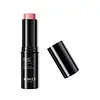What's inside
What's inside
 Key Ingredients
Key Ingredients

 Benefits
Benefits

 Concerns
Concerns

 Ingredients Side-by-side
Ingredients Side-by-side

Isononyl Isononanoate
EmollientMica
Cosmetic ColorantPolyethylene
AbrasiveSynthetic Wax
AbrasiveNeopentyl Glycol Dicaprylate/Dicaprate
EmollientPolymethylsilsesquioxane
Talc
AbrasiveZinc Stearate
Cosmetic ColorantSilica
AbrasiveDimethicone
EmollientEthylene Brassylate
MaskingPentaerythrityl Tetra-Di-T-Butyl Hydroxyhydrocinnamate
AntioxidantPlukenetia Volubilis Seed Oil
EmollientPistacia Vera Seed Oil
Skin ConditioningHydrogenated Vegetable Oil
EmollientTocopherol
AntioxidantBHT
AntioxidantTin Oxide
AbrasiveTitanium Dioxide
Cosmetic ColorantCI 77491
Cosmetic ColorantCI 15850
Cosmetic ColorantCI 19140
Cosmetic ColorantCI 45410
Cosmetic ColorantCI 73360
Cosmetic ColorantIsononyl Isononanoate, Mica, Polyethylene, Synthetic Wax, Neopentyl Glycol Dicaprylate/Dicaprate, Polymethylsilsesquioxane, Talc, Zinc Stearate, Silica, Dimethicone, Ethylene Brassylate, Pentaerythrityl Tetra-Di-T-Butyl Hydroxyhydrocinnamate, Plukenetia Volubilis Seed Oil, Pistacia Vera Seed Oil, Hydrogenated Vegetable Oil, Tocopherol, BHT, Tin Oxide, Titanium Dioxide, CI 77491, CI 15850, CI 19140, CI 45410, CI 73360
Octyldodecanol
EmollientHydrogenated Polyisobutene
EmollientHydrogenated Poly(C6-14 Olefin)
EmollientPolyethylene
AbrasiveSilica
AbrasiveDiisostearyl Malate
EmollientSynthetic Wax
AbrasiveSynthetic Fluorphlogopite
Sorbitan Isostearate
EmulsifyingEthylene/Propylene Copolymer
AbrasiveCera Microcristallina
Emulsion StabilisingTocopherol
AntioxidantMethicone
EmollientTriethoxycaprylylsilane
BHT
AntioxidantCI 77891
Cosmetic ColorantCI 77492
Cosmetic ColorantCI 15850
Cosmetic ColorantCI 19140
Cosmetic ColorantOctyldodecanol, Hydrogenated Polyisobutene, Hydrogenated Poly(C6-14 Olefin), Polyethylene, Silica, Diisostearyl Malate, Synthetic Wax, Synthetic Fluorphlogopite, Sorbitan Isostearate, Ethylene/Propylene Copolymer, Cera Microcristallina, Tocopherol, Methicone, Triethoxycaprylylsilane, BHT, CI 77891, CI 77492, CI 15850, CI 19140
 Reviews
Reviews

Ingredients Explained
These ingredients are found in both products.
Ingredients higher up in an ingredient list are typically present in a larger amount.
BHT is a synthetic antioxidant and preservative.
As an antioxidant, it helps your body fight off free-radicals. Free-radicals are molecules that may damage your skin cells.
As a preservative, it is used to stabilize products and prevent them from degrading. Specifically, BHT prevents degradation from oxidation.
The concerns related to BHT come from oral studies; this ingredient is currently allowed for use by both the FDA and EU.
However, it was recently restricted for use in the UK as of April 2024.
Learn more about BHTCi 15850 is the pigment color red. It is an azo dye and created synthetically.
Azo dyes need to be thoroughly purified before use. This allows them to be more stable and longer-lasting.
This ingredient is common in foundations, lipsticks, and blushes. This color is described as brown/orangey red.
It has many secondary names such as Red 6 and Red 7. According to a manufacturer, Red 6 usually contains aluminum.
Learn more about CI 15850CI 19140 is also known as Tartrazine. Tartrazine is a synthetic dye used in cosmetics, foods, and medicine to add a yellow color.
Tartrazine is created from petroleum and is water-soluble.
Some people may experience allergies from this dye, especially asthmatics and those with an aspirin intolerance.
Learn more about CI 19140Polyethylene is a synthetic ingredient that helps the skin retain moisture. It is a polymer.
It is also typically used within product formulations to help bind solid ingredients together and thicken oil-based ingredients. When added to balms and emulsions, it helps increase the melting point temperature.
Silica, also known as silicon dioxide, is a naturally occurring mineral. It is used as a fine, spherical, and porous powder in cosmetics.
Though it has exfoliant properties, the function of silica varies depending on the product.
The unique structure of silica enhances the spreadability and adds smoothness, making it a great texture enhancer.
It is also used as an active carrier, emulsifier, and mattifier due to its ability to absorb excess oil.
In some products, tiny microneedles called spicules are made from silica or hydrolyzed sponge. When you rub them in, they lightly polish away dead skin layers and enhance the penetration of active ingredients.
Learn more about SilicaSynthetic Wax is created from fossil fuels such as natural gas. It is used to enhance texture, adjust pH, and as an occlusive.
It may also be used as an abrasive ingredient to exfoliate the skin.
Synthetic Wax may not be fungal acne safe.
Learn more about Synthetic WaxTocopherol (also known as Vitamin E) is a common antioxidant used to help protect the skin from free-radicals and strengthen the skin barrier. It's also fat soluble - this means our skin is great at absorbing it.
Vitamin E also helps keep your natural skin lipids healthy. Your lipid skin barrier naturally consists of lipids, ceramides, and fatty acids. Vitamin E offers extra protection for your skin’s lipid barrier, keeping your skin healthy and nourished.
Another benefit is a bit of UV protection. Vitamin E helps reduce the damage caused by UVB rays. (It should not replace your sunscreen). Combining it with Vitamin C can decrease sunburned cells and hyperpigmentation after UV exposure.
You might have noticed Vitamin E + C often paired together. This is because it is great at stabilizing Vitamin C. Using the two together helps increase the effectiveness of both ingredients.
There are often claims that Vitamin E can reduce/prevent scarring, but these claims haven't been confirmed by scientific research.
Learn more about Tocopherol